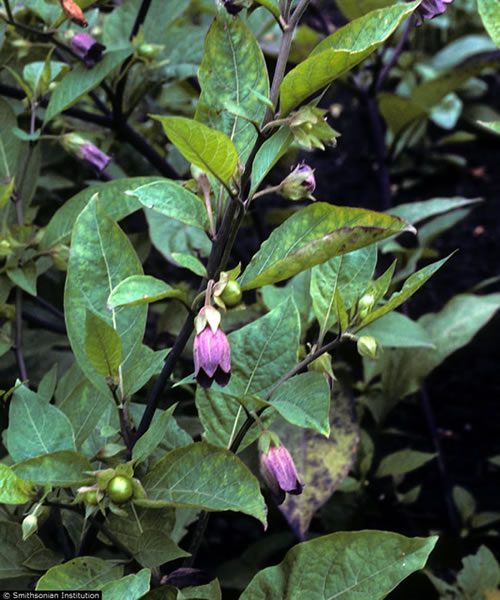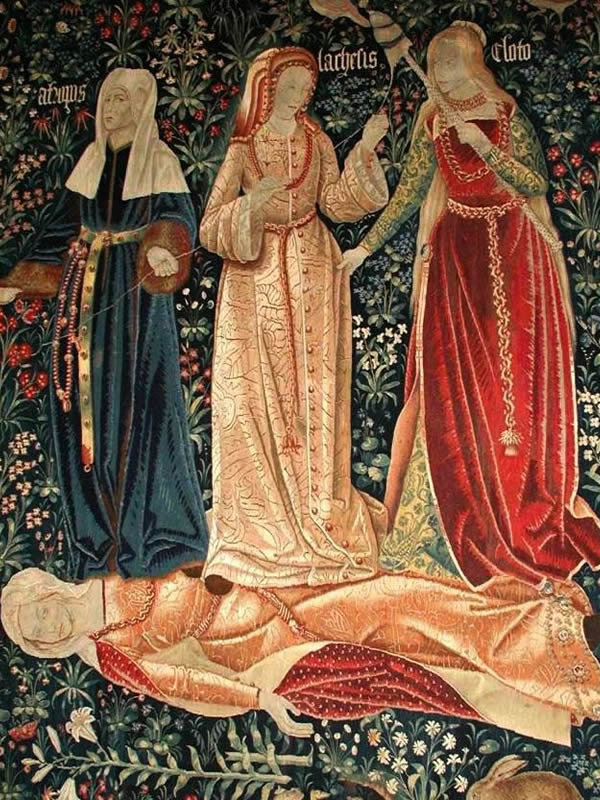The Powerful Solanaceae: Belladonna

Deadly nightshade, belladonna, Devil’s cherries (Atropa belladonna)
The original range of Atropa belladonna was from southern Europe to Asia but today is naturalized in many parts of the world. Photo credit: Smithsonian Institution.
This extremely poisonous plant has a long and colorful history of use and abuse. When Linnaeus formally applied a scientific name to this plant in 1753, he acknowledged its toxic nature as well as its social value.
In Greek mythology, the three Fates (Moirai) were responsible for spinning, measuring the length of human life, and ending it. Clotho spins the thread of life, Lachesis measures and allots the length of one’s life, and Atropos severs it. The genus name of belladonna is a derivation of Atropos, meaning “inexorable” or “inflexible,” the Fate that severs the thread of life.
The species epithet comes from the Italian word “belladonna” for beautiful woman, a reference to this plants’ use by Venetian ladies of the court who dilated their pupils with a tincture of belladonna eye-drops. There is a painting, “Woman with a Mirror” by the Renaissance painter, Titian, that hangs in the Louvre Museum. It pictures a young, beautiful Venetian “belladonna” who may have used atropine drops to dilate the pupils of her eyes to enhance their beauty.
In addition to atropine, which does indeed affect the pupils of the eye, several other highly toxic and potent psychoactive tropane alkaloids are found in belladonna, including hyoscyamine and scopolamine. All parts of the plant are toxic, but the sweet, purplish-black berries that are attractive to children pose the greatest danger. Symptoms of poisoning include rapid heart beat, dilated pupils, delirium, vomiting, hallucinations, and death due to respiratory failure. Handling the plant can expose a person to absorbing toxins through the skin or cause severe dermatitis. Belladonna is also highly toxic to domestic animals causing paralysis and death.
 Atropa belladonna is a medium sized shrub with dark green leaves and distinct purple bell-shaped flowers. The original range of this species was from southern Europe to Asia but today is naturalized in many parts of the world. Photo credit: Smithsonian Institution.
Atropa belladonna is a medium sized shrub with dark green leaves and distinct purple bell-shaped flowers. The original range of this species was from southern Europe to Asia but today is naturalized in many parts of the world. Photo credit: Smithsonian Institution.
With all these highly toxic compounds, one might wonder why deadly nightshade was and is still being used by people. As with many poisonous plants there are many reasons for their use, both good (medicinal) and bad (weapons and poisons). The Romans used belladonna as a biological weapon to contaminate their enemies’ food reserves. In Shakespeare’s play, Macbeth, the Scottish army defeats the Danes by contaminating their liquor supply with belladonna, inducing a deep, comatose sleep, and murdering them in their hapless state. Deadly nightshade was also an important plant in the medieval witches’ pharmacopoeia in brews and salves, used as a constituent in their flying ointments. During World War II, the Germans invented a deadly, odorless nerve gas and the only antidote to its paralyzing effects turned out to be atropine.
Today, various medicinal preparations of belladonna are in use. Ophthalmologists use atropine to dilate their patient’s pupils for eye-exams and surgery. Atropine is also used as an antidote to opium and chloroform poisoning. Various preparations of belladonna are used as lotions, plasters and salves to relieve pain from sciatica, gout, and cardiac palpitations.
Did You Know?
- The oral overdose level for belladonna is only 600 milligrams.
- Only 1 part to 130,000 parts water is sufficient to dilate the pupils.
- The wives of Roman emperors Augustus and Claudius poisoned them with atropine.
- People have been poisoned by eating honey that contained significant amounts of atropine.
- Belladonna (Took) Baggins was Bilbo Baggins' mother in the “Hobbit”.








